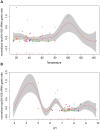A Combination of Extreme Environmental Conditions Favor the Prevalence of Endospore-Forming Firmicutes
- PMID: 27857706
- PMCID: PMC5094177
- DOI: 10.3389/fmicb.2016.01707
A Combination of Extreme Environmental Conditions Favor the Prevalence of Endospore-Forming Firmicutes
Abstract
Environmental conditions unsuitable for microbial growth are the rule rather than the exception in most habitats. In response to this, microorganisms have developed various strategies to withstand environmental conditions that limit active growth. Endospore-forming Firmicutes (EFF) deploy a myriad of survival strategies in order to resist adverse conditions. Like many bacterial groups, they can form biofilms and detect nutrient scarcity through chemotaxis. Moreover, within this paraphyletic group of Firmicutes, ecophysiological optima are diverse. Nonetheless, a response to adversity that delimits this group is the formation of wet-heat resistant spores. These strategies are energetically demanding and therefore might affect the biological success of EFF. Therefore, we hypothesize that abundance and diversity of EFF should be maximized in those environments in which the benefits of these survival strategies offsets the energetic cost. In order to address this hypothesis, geothermal and mineral springs and drillings were selected because in these environments of steep physicochemical gradients, diversified survival strategies may become a successful strategy.We collected 71 samples from geothermal and mineral environments characterized by none (null), single or multiple limiting environmental factors (temperature, pH, UV radiation, and specific mineral composition). To measure success, we quantified EFF gene copy numbers (GCN; spo0A gene) in relation to total bacterial GCN (16S rRNA gene), as well as the contribution of EFF to community composition. The quantification showed that relative GCN for EFF reached up to 20% at sites characterized by multiple limiting environmental factors, whereas it corresponded to less than 1% at sites with one or no limiting environmental factor. Pyrosequencing of the 16S rRNA gene supports a higher contribution of EFF at sites with multiple limiting factors. Community composition suggested a combination of phylotypes for which active growth could be expected, and phylotypes that are most likely in the state of endospores, in all the sites. In summary, our results suggest that diversified survival strategies, including sporulation and metabolic adaptations, explain the biological success of EFF in geothermal and natural springs, and that multiple extreme environmental factors favor the prevalence of EFF.
Keywords: 16S rRNA gene; Clostridium; Firmicutes; endospores; geothermal springs; mineral springs; qPCR; spo0A.
Figures



References
-
- Barton L. (2005). Structural and Functional Relationships in Prokaryotes. New York, NY: Springer Science & Business Media.
LinkOut - more resources
Full Text Sources
Other Literature Sources

